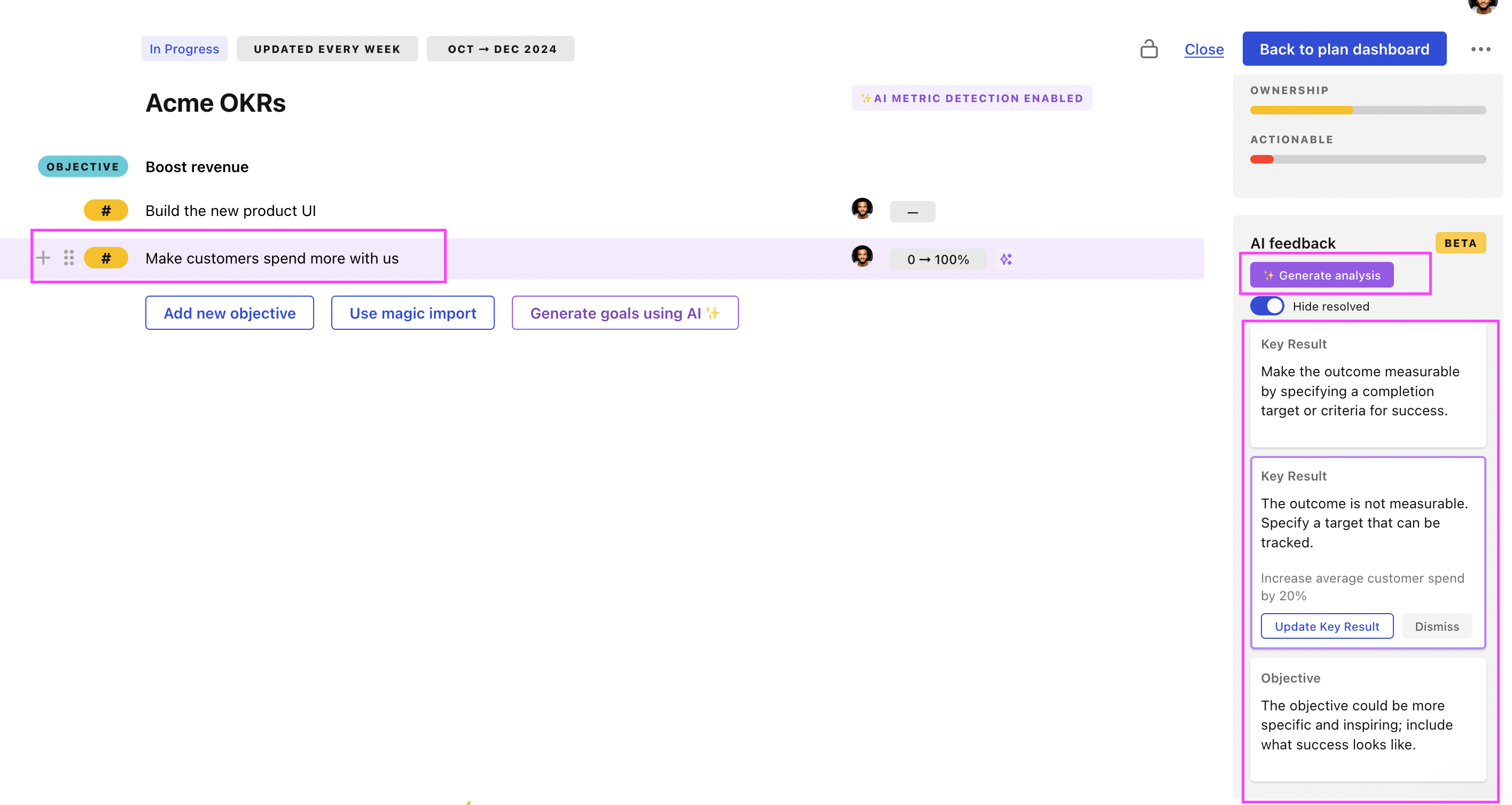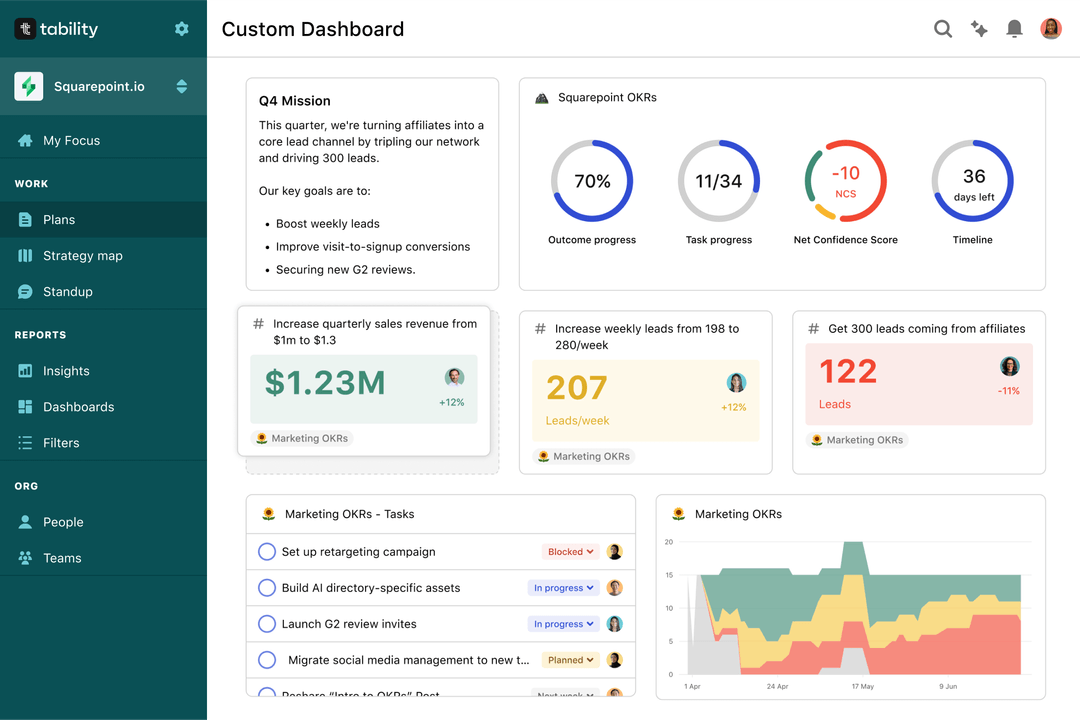Tability is a cheatcode for goal-driven teams. Set perfect OKRs with AI, stay focused on the work that matters.
What are Organizational Efficiency OKRs?
The OKR acronym stands for Objectives and Key Results. It's a goal-setting framework that was introduced at Intel by Andy Grove in the 70s, and it became popular after John Doerr introduced it to Google in the 90s. OKRs helps teams has a shared language to set ambitious goals and track progress towards them.
Crafting effective OKRs can be challenging, particularly for beginners. Emphasizing outcomes rather than projects should be the core of your planning.
We've tailored a list of OKRs examples for Organizational Efficiency to help you. You can look at any of the templates below to get some inspiration for your own goals.
If you want to learn more about the framework, you can read our OKR guide online.
The best tools for writing perfect Organizational Efficiency OKRs
Here are 2 tools that can help you draft your OKRs in no time.
Tability AI: to generate OKRs based on a prompt
Tability AI allows you to describe your goals in a prompt, and generate a fully editable OKR template in seconds.
- 1. Create a Tability account
- 2. Click on the Generate goals using AI
- 3. Describe your goals in a prompt
- 4. Get your fully editable OKR template
- 5. Publish to start tracking progress and get automated OKR dashboards
Watch the video below to see it in action 👇
Tability Feedback: to improve existing OKRs
You can use Tability's AI feedback to improve your OKRs if you already have existing goals.
- 1. Create your Tability account
- 2. Add your existing OKRs (you can import them from a spreadsheet)
- 3. Click on Generate analysis
- 4. Review the suggestions and decide to accept or dismiss them
- 5. Publish to start tracking progress and get automated OKR dashboards

Tability will scan your OKRs and offer different suggestions to improve them. This can range from a small rewrite of a statement to make it clearer to a complete rewrite of the entire OKR.
Organizational Efficiency OKRs examples
You will find in the next section many different Organizational Efficiency Objectives and Key Results. We've included strategic initiatives in our templates to give you a better idea of the different between the key results (how we measure progress), and the initiatives (what we do to achieve the results).
Hope you'll find this helpful!
OKRs to boost overall organization efficiency and revenue
ObjectiveBoost overall organization efficiency and revenue
KRIncrease quarterly revenue by 15% through targeted marketing strategies
Evaluate and adjust marketing strategy based on results regularly
Implement highly specialized promotional campaigns for potential clients
Develop a comprehensive client profile for effective targeted marketing
KRRaise social media engagement rate 20% to improve content visibility
Respond promptly to comments, messages, and shares on your posts
Use trending hashtags and keywords to attract a larger audience
Create more interactive content such as quizzes, polls, or contests
KRImplement new employee training for process efficiency, reducing errors by 25%
Develop targeted training materials for current processes
Schedule and conduct training sessions for staff
Monitor error rates and make necessary adjustments to training
OKRs to enhance overall organizational efficiency and effectiveness
ObjectiveEnhance overall organizational efficiency and effectiveness
KRHike employee productivity by 20% via holistic skill development programs
Implement comprehensive skill development programs for all employees
Offer frequent training courses focused on efficiency and productivity
Encourage frequent inter-department knowledge sharing sessions
KRIncrease internal process efficiency by 30% through streamlined workflow methods
Identify current operational bottlenecks impacting efficiency
Develop and implement streamlined workflow strategies
Monitor and adjust strategies regularly for improvement
KRDecrease operational costs by 15% through efficient resource utilization
Implement energy-saving measures across all company operations
Optimize supply chain management to reduce excess costs
Enhance employee productivity through targeted training
OKRs to significantly improve organizational efficiency through AI and process automation
ObjectiveSignificantly improve organizational efficiency through AI and process automation
KRImplement AI in at least two crucial operational areas to increase productivity by 20%
Research and select suitable AI tools or solutions
Plan and execute AI integration procedures
Identify two operational areas with potential for AI implementation
KRTrain 70% of the team on AI tools and automation for effective utilization
Arrange AI tools and automation training sessions
Monitor and evaluate training progress and productivity
Identify team members for AI and automation training
KRAutomate 30% of existing routine manual processes to save time
Identify 30% most time-consuming routine manual processes
Implement and test selected automation solutions
Research automation tools for identified processes
OKRs to enhance personal organization
ObjectiveEnhance personal organization
KRMaster a productivity app, increasing task completion rate by 25%
Utilize the app regularly to manage tasks
Research and select a high-rated productivity app
Spend daily time learning the app's features
KRMinimize clutter: clean and organize workspace, achieving a 50% reduction
Remove unnecessary items from workspace
Implement regular cleaning schedule
Install organizing tools like shelves, drawers
KRImplement a daily scheduling routine to track all activities by week 1
Monitor and adjust the schedule daily
Purchase a daily planner or download a scheduling app
Allocate time slots for all daily activities
OKRs to enhance organizational performance to high-performing standards
ObjectiveEnhance organizational performance to high-performing standards
KRImplement process improvements to increase operational efficiency by 20%
Develop and execute change strategies for efficiency
Identify bottlenecks within the existing operational process
Measure and compare process effectiveness pre/post-change
KRReduce employee turnover rate by 15% through effective talent engagement strategies
Implement mentorship programs to facilitate career growth
Enhance communication channels for employee feedback
Develop comprehensive benefits and recognition programs
KRIncrease customer satisfaction levels by achieving a 10% rise in positive feedback scores
Implement regular staff training for superior customer service
Develop and promote a user-friendly feedback system
Enhance product quality and user experience
Organizational Efficiency OKR best practices
Generally speaking, your objectives should be ambitious yet achievable, and your key results should be measurable and time-bound (using the SMART framework can be helpful). It is also recommended to list strategic initiatives under your key results, as it'll help you avoid the common mistake of listing projects in your KRs.
Here are a couple of best practices extracted from our OKR implementation guide 👇
Tip #1: Limit the number of key results
The #1 role of OKRs is to help you and your team focus on what really matters. Business-as-usual activities will still be happening, but you do not need to track your entire roadmap in the OKRs.
We recommend having 3-4 objectives, and 3-4 key results per objective. A platform like Tability can run audits on your data to help you identify the plans that have too many goals.
Tip #2: Commit to weekly OKR check-ins
Don't fall into the set-and-forget trap. It is important to adopt a weekly check-in process to get the full value of your OKRs and make your strategy agile – otherwise this is nothing more than a reporting exercise.
Being able to see trends for your key results will also keep yourself honest.
Tip #3: No more than 2 yellow statuses in a row
Yes, this is another tip for goal-tracking instead of goal-setting (but you'll get plenty of OKR examples above). But, once you have your goals defined, it will be your ability to keep the right sense of urgency that will make the difference.
As a rule of thumb, it's best to avoid having more than 2 yellow/at risk statuses in a row.
Make a call on the 3rd update. You should be either back on track, or off track. This sounds harsh but it's the best way to signal risks early enough to fix things.
Save hours with automated Organizational Efficiency OKR dashboards

Your quarterly OKRs should be tracked weekly if you want to get all the benefits of the OKRs framework. Reviewing progress periodically has several advantages:
- It brings the goals back to the top of the mind
- It will highlight poorly set OKRs
- It will surface execution risks
- It improves transparency and accountability
We recommend using a spreadsheet for your first OKRs cycle. You'll need to get familiar with the scoring and tracking first. Then, you can scale your OKRs process by using Tability to save time with automated OKR dashboards, data connectors, and actionable insights.
How to get Tability dashboards:
- 1. Create a Tability account
- 2. Use the importers to add your OKRs (works with any spreadsheet or doc)
- 3. Publish your OKR plan
That's it! Tability will instantly get access to 10+ dashboards to monitor progress, visualise trends, and identify risks early.
More Organizational Efficiency OKR templates
We have more templates to help you draft your team goals and OKRs.
OKRs to instill a problem-solving mindset across the team
OKRs to become a proficient Front End technical lead
OKRs to develop an effective project portfolio management software
OKRs to expand lour brand's presence through impactful outreach
OKRs to publish an engaging Android app and acquire monthly subscribers
OKRs to identify and assess new growth opportunities